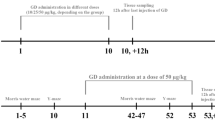Abstract
A non-selective antihistamine, dimebon, has recently emerged as a potential treatment for Alzheimer’s disease and Huntington’s disease. Dimebon exerts several effects in addition to its anti-histaminergic effect, and of particular interest is its ability to enhance cognitive function in several models. The mechanism underlying this is unknown though it has been suggested that it may be associated with its anti-cholinergic action. Dimebon has also been reported to be neuroprotective, perhaps as a result of its ability to stabilize mitochondria. We considered that these effects might impact on the well-described age-related impairment in spatial learning and therefore examined the effect of repeated administration of dimebon on performance of young and aged animals in the Morris water maze. Whereas a clear age-related deficit was observed, dimebon failed to exert any effect on performance. Similarly, dimebon exerted no effect on the age-related increase in hippocampal expression of several markers of microglial and astroglial activation. We conclude that, despite its cognitive enhancing effects in some models, dimebon failed to modulate the deficit in spatial learning in aged rats and the evidence suggests that the drug does not possess anti-inflammatory properties.





Similar content being viewed by others
References
Bachurin S, Bukatina E, Lermontova N et al (2001) Antihistamine agent Dimebon as a novel neuroprotector and a cognition enhancer. Ann N Y Acad Sci 939:425–435
Bachurin SO, Shelkovnikova TA, Ustyugov AA et al (2012) Dimebon slows progression of proteinopathy in gamma-synuclein transgenic mice. Neurotox Res 22:33–42
Bachurin SO, Shevtsova EP, Kireeva EG et al (2003) Mitochondria as a target for neurotoxins and neuroprotective agents. Ann N Y Acad Sci 993:334–344; discussion 345–349
Barnes CA (1979) Memory deficits associated with senescence: a neurophysiological and behavioral study in the rat. J Comp Physiol Psychol 93:74–104
Blau CW, Cowley TR, O’Sullivan J et al (2012) The age-related deficit in LTP is associated with changes in perfusion and blood-brain barrier permeability. Neurobiol Aging 33(5):1005.e23–35
Cowley TR, O’Sullivan J, Blau C et al (2012) Rosiglitazone attenuates the age-related changes in astrocytosis and the deficit in LTP. Neurobiol Aging 33:162–175
Cox FF, Carney D, Miller AM et al (2012) CD200 fusion protein decreases microglial activation in the hippocampus of aged rats. Brain Behav Immun 26(5):789–796
Doody RS, Gavrilova SI, Sano M et al (2008) Effect of dimebon on cognition, activities of daily living, behaviour, and global function in patients with mild-to-moderate Alzheimer’s disease: a randomised, double-blind, placebo-controlled study. Lancet 372:207–215
Ferreira R, Santos T, Goncalves J et al (2012) Histamine modulates microglia function. J Neuroinflammation 9:90
Giorgetti M, Gibbons JA, Bernales S et al (2010) Cognition-enhancing properties of Dimebon in a rat novel object recognition task are unlikely to be associated with acetylcholinesterase inhibition or N-methyl-D-aspartate receptor antagonism. J Pharmacol Exp Ther 333:748–757
Godbout JP, Johnson RW (2009) Age and neuroinflammation: a lifetime of psychoneuroimmune consequences. Immunol Allerg Clin North Am 29:321–337
Grigor’ev VV, Garibova TL, Voronina TA et al (2009) Effects of chronic administration of dimebon on behavior and memory of SAMP 10 mice. Eksperimental’naia i klinicheskaia farmakologiia 72:52–56
Grigorev VV, Dranyi OA, Bachurin SO (2003) Comparative study of action mechanisms of dimebon and memantine on AMPA- and NMDA-subtypes glutamate receptors in rat cerebral neurons. Bull Exp Biol Med 136:474–477
Ionov ID, Severtsev NN (2012) Histamine- and haloperidol-induced catalepsy in aged mice: differential responsiveness to L: -DOPA. Psychopharmacology 223:191–197
Jones RW (2010) Dimebon disappointment. Alzheimer’s Res Ther 2:25
Kelly L, Grehan B, Chiesa AD et al (2011) The polyunsaturated fatty acids, EPA and DPA exert a protective effect in the hippocampus of the aged rat. Neurobiol Aging 32:2318.e1–15
Lermontova NN, Lukoyanov NV, Serkova TP et al (2000) Dimebon improves learning in animals with experimental Alzheimer’s disease. Bull Exp Biol Med 129:544–546
Lynch MA (2010) Age-related neuroinflammatory changes negatively impact on neuronal function. Front Aging Neurosci 1:6
Moreira PI, Zhu X, Wang X et al (2010) Mitochondria: a therapeutic target in neurodegeneration. Biochim Biophys Acta 1802:212–220
Rosenzweig ES, Barnes CA (2003) Impact of aging on hippocampal function: plasticity, network dynamics, and cognition. Prog Neurobiol 69:143–179
Sachdeva D, Burns A (2011) Dimebolin in Dementia. CNS Neurosci Ther 17(3):199–205
Schaffhauser H, Mathiasen JR, Dicamillo A et al (2009) Dimebolin is a 5-HT6 antagonist with acute cognition enhancing activities. Biochem Pharmacol 78:1035–1042
Steele JW, Lachenmayer ML, Ju S et al (2012) Latrepirdine improves cognition and arrests progression of neuropathology in an Alzheimer’s mouse model. Mol Psychiatry [Epub ahead of print]
Terao A, Steininger TL, Morairty SR et al (2004) Age-related changes in histamine receptor mRNA levels in the mouse brain. Neurosci Lett 355:81–84
Vanguilder HD, Bixler GV, Brucklacher RM et al (2011) Concurrent hippocampal induction of MHC II pathway components and glial activation with advanced aging is not correlated with cognitive impairment. J Neuroinflammation 8:138
Vignisse J, Steinbusch HW, Bolkunov A et al (2011) Dimebon enhances hippocampus-dependent learning in both appetitive and inhibitory memory tasks in mice. Prog Neuropsychopharmacol Biol Psychiatry 35:510–522
Vizuete ML, Merino M, Venero JL et al (2000) Histamine infusion induces a selective dopaminergic neuronal death along with an inflammatory reaction in rat substantia nigra. J Neurochem 75:540–552
Wang BW, Hok V, Della-Chiesa A et al (2012) Rosiglitazone enhances learning, place cell activity, and synaptic plasticity in middle-aged rats. Neurobiol Aging 33:835.e13–e30
Webster SJ, Wilson CA, Lee CH et al (2011) The acute effects of dimebolin, a potential Alzheimer’s disease treatment, on working memory in rhesus monkeys. Br J Pharmacol 164:970–978
Wu J, Li Q, Bezprozvanny I (2008) Evaluation of Dimebon in cellular model of Huntington’s disease. Mol Neurodegener 3:15
Acknowledgments
This work was supported by GlaxoSmithKline and the Industrial Development Agency Ireland. RE G-R was funded by the Health Research Board Ireland (grant number PhD/2007/13).
Author information
Authors and Affiliations
Corresponding author
Additional information
Special Issue: In Honor of Elisabeth Bock.
Rights and permissions
About this article
Cite this article
Cowley, T.R., González-Reyes, R.E., Richardson, J.C. et al. The Age-related Gliosis and Accompanying Deficit in Spatial Learning are Unaffected by Dimebon. Neurochem Res 38, 1190–1195 (2013). https://doi.org/10.1007/s11064-012-0884-0
Received:
Revised:
Accepted:
Published:
Issue Date:
DOI: https://doi.org/10.1007/s11064-012-0884-0




